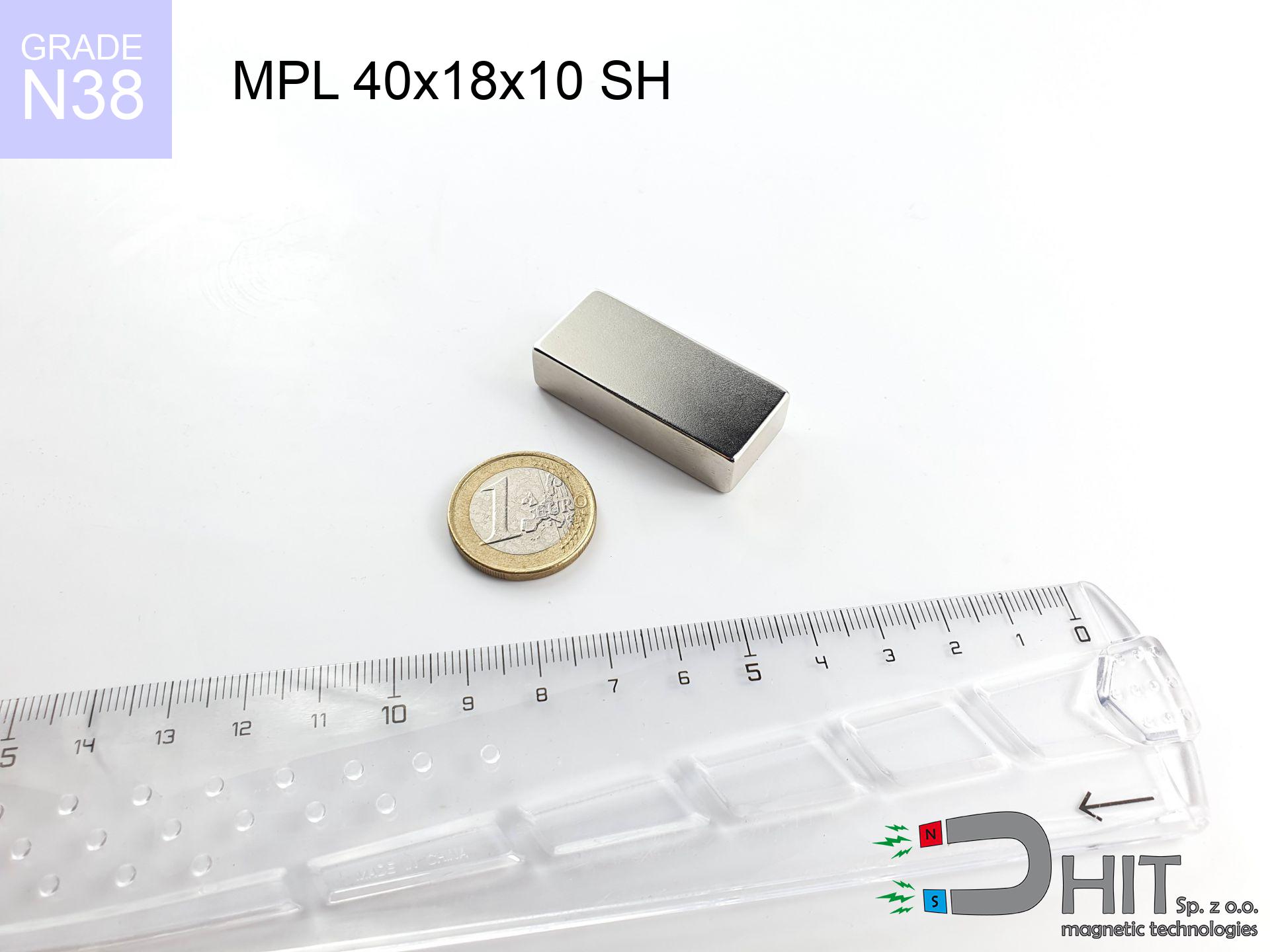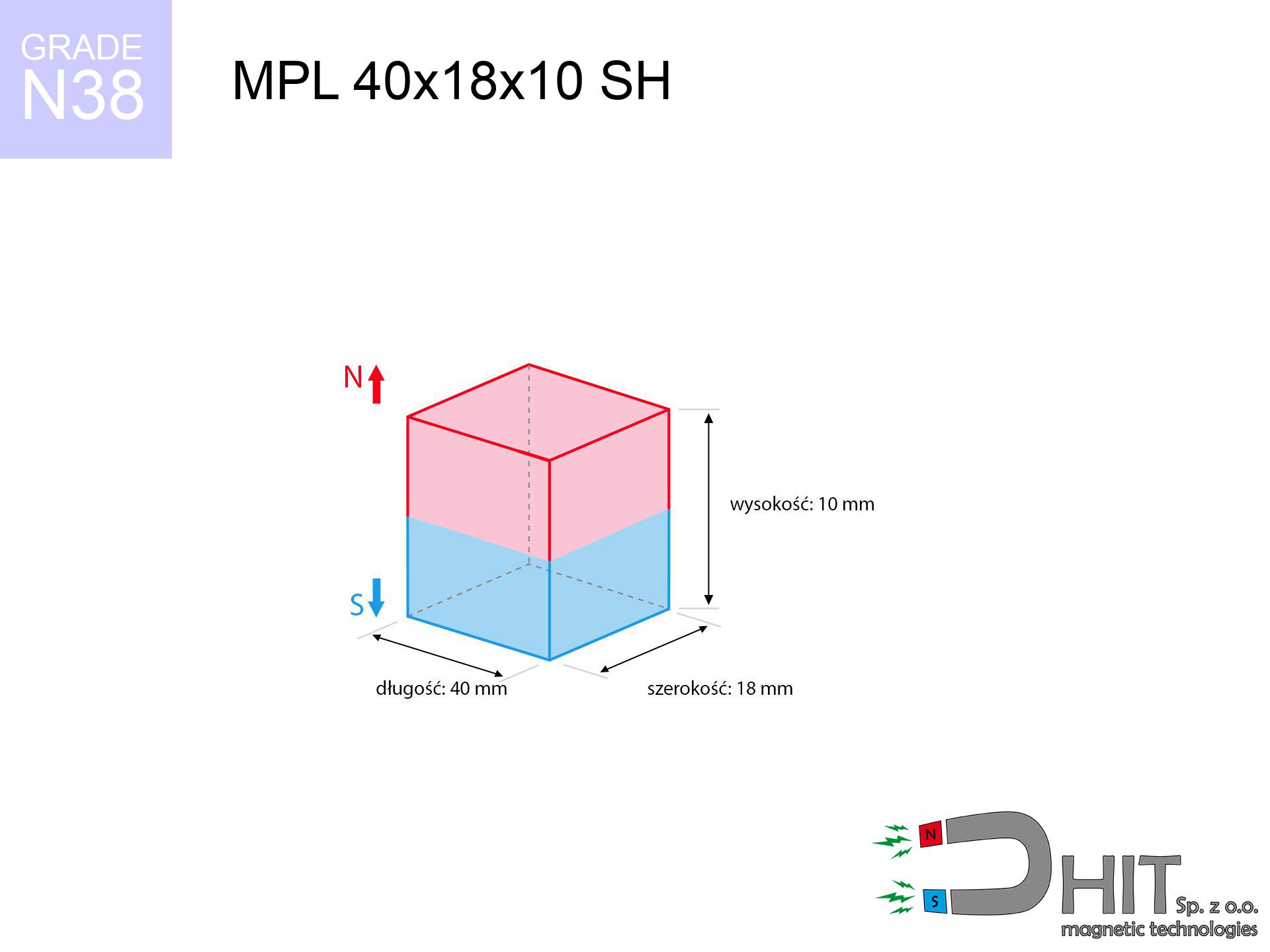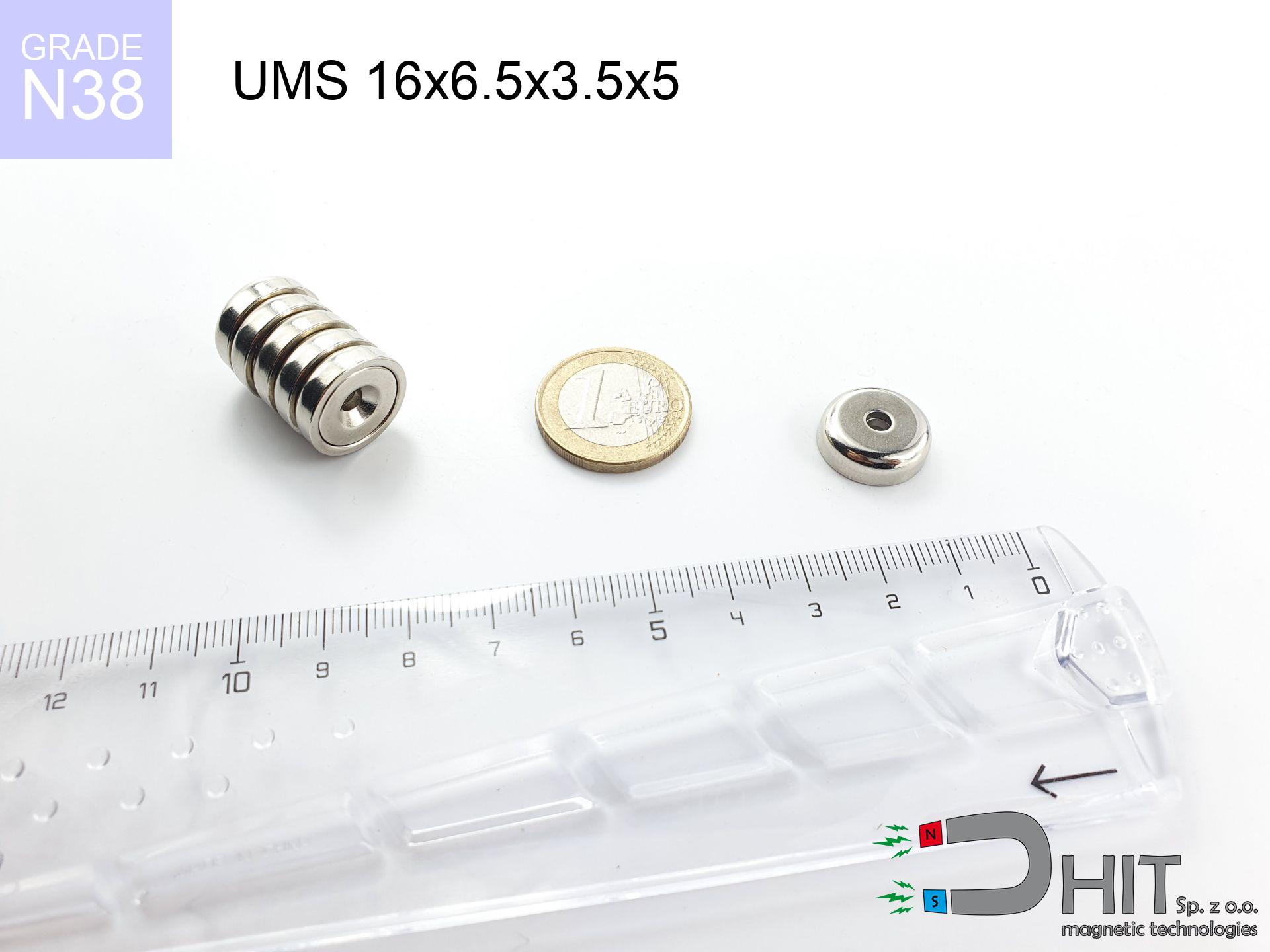MPL 40x18x10 SH / N38 - lamellar magnet
lamellar magnet
Catalog no 020157
GTIN: 5906301811633
length [±0,1 mm]
40 mm
Width [±0,1 mm]
18 mm
Height [±0,1 mm]
10 mm
Weight
54 g
Magnetization Direction
↑ axial
Magnetic Induction
366.66 mT
Coating
[NiCuNi] nickel
33.83 ZŁ with VAT / pcs + price for transport
27.50 ZŁ net + 23% VAT / pcs
bulk discounts:
Need more?Want to negotiate the price?
Call us +48 22 499 98 98 or write via form on the contact page. Test the magnet's power with our power calculator.
Orders placed by 14:00 are shipped the same day.
MPL 40x18x10 SH / N38 - lamellar magnet
Magnetic properties of material N38
Physical properties of NdFeB
Shopping tips
Thanks to their high strength, flat magnets are commonly used in structures that require strong holding power.
The standard temperature resistance of these magnets is 80°C, but depending on the dimensions, this value grows.
Additionally, flat magnets commonly have special coatings applied to their surfaces, such as nickel, gold, or chrome, to improve their durability.
The magnet named MPL 40x18x10 SH / N38 i.e. a magnetic strength 0 kg with a weight of just 54 grams, making it the ideal choice for applications requiring a flat shape.
Contact surface: Due to their flat shape, flat magnets ensure a greater contact surface with other components, which can be beneficial in applications needing a stronger magnetic connection.
Technology applications: These are often used in different devices, such as sensors, stepper motors, or speakers, where the flat shape is necessary for their operation.
Mounting: The flat form's flat shape makes mounting, especially when it is required to attach the magnet to another surface.
Design flexibility: The flat shape of the magnets allows designers greater flexibility in placing them in devices, which can be more difficult with magnets of more complex shapes.
Stability: In some applications, the flat base of the flat magnet can provide better stability, minimizing the risk of shifting or rotating. However, one should remember that the optimal shape of the magnet is dependent on the given use and requirements. In some cases, other shapes, like cylindrical or spherical, are more appropriate.
Magnets have two poles: north (N) and south (S), which attract each other when they are oppositely oriented. Poles of the same kind, such as two north poles, repel each other.
Due to these properties, magnets are often used in electrical devices, such as motors, speakers, sensors, or magnetic locks. Neodymium magnets stand out with the greatest strength of attraction, making them perfect for applications requiring strong magnetic fields. Moreover, the strength of a magnet depends on its size and the materials used.
It should be noted that high temperatures can weaken the magnet's effect. The Curie temperature is specific to each type of magnet, meaning that under such conditions, the magnet stops being magnetic. Additionally, strong magnets can interfere with the operation of devices, such as navigational instruments, credit cards or electronic devices sensitive to magnetic fields. For this reason, it is important to exercise caution when using magnets.
Advantages and disadvantages of neodymium magnets NdFeB.
Apart from immense strength, neodymium magnets have the following advantages:
- They do not lose their power (of the magnet). After approximately 10 years, their power decreases by only ~1% (theoretically),
- They are highly resistant to demagnetization by external magnetic sources,
- Thanks to the shiny finish and nickel, gold, or silver coating, they have an aesthetic appearance,
- They exhibit very high magnetic induction on the surface of the magnet,
- Thanks to their high temperature resistance, they can operate (depending on the shape) even at temperatures up to 230°C and above...
- Thanks to the flexibility in shaping or the ability to adapt to specific requirements – neodymium magnets can be produced in a wide range of shapes and sizes, which expands the range of their possible uses.
- Significant importance in the industry of new technologies – are utilized in computer drives, electric drive mechanisms, medical devices and very modern machines.
Disadvantages of neodymium magnets:
- They are fragile when subjected to a powerful impact. If the magnets are exposed to impacts, we recommend using magnets in a metal holder. The steel housing in the form of a holder protects the magnet from impacts, and at the same time increases its overall strength,
- High temperatures can reduce the strength of neodymium magnets. Typically, after heating above 80°C, most of them experience a permanent loss in strength (although it is dependent on the shape and size). To prevent this, we offer special magnets marked with the symbol [AH], which are highly resistant to high temperatures. They can operate even at temperatures up to 230°C, making them an ideal solution for applications requiring high-temperature operation,
- They rust in a humid environment - during outdoor use, we recommend using waterproof magnets, such as those made of rubber or plastic,
- The use of a cover - a magnetic holder is recommended due to the limited production capabilities of creating threads or complex shapes in the magnet
- Health risk associated with microscopic parts of magnets pose a threat, if swallowed, which becomes significant in the aspect of protecting young children. Additionally, small elements of these magnets have the potential to be problematic in medical diagnosis when they are in the body.
Precautions
Do not place neodymium magnets near a computer HDD, TV, and wallet.
Strong magnetic fields emitted by neodymium magnets can damage magnetic storage media such as floppy disks, credit cards, magnetic ID cards, cassette tapes, video tapes, or other devices. They can also damage televisions, VCRs, computer monitors, and CRT displays. You should especially avoid placing neodymium magnets near electronic devices.
The magnet coating is made of nickel, so be cautious if you have an allergy.
Studies show a small percentage of people have allergies to certain metals, including nickel. An allergic reaction often manifests as skin redness and rash. If you have a nickel allergy, try wearing gloves or avoid direct contact with nickel-plated neodymium magnets.
Neodymium magnetic are extremely fragile, they easily fall apart and can crumble.
Neodymium magnets are characterized by significant fragility. Magnets made of neodymium are made of metal and coated with a shiny nickel, but they are not as durable as steel. At the moment of collision between the magnets, sharp metal fragments can be dispersed in different directions.
Dust and powder from neodymium magnets are flammable.
Do not attempt to drill into neodymium magnets. Mechanical processing is also not recommended. Once crushed into fine powder or dust, this material becomes highly flammable.
Neodymium magnets are the strongest magnets ever created, and their strength can shock you.
To use magnets properly, it is best to familiarize yourself with our information beforehand. This will help you avoid significant harm to your body and the magnets themselves.
Magnets are not toys, children should not play with them.
Remember that neodymium magnets are not toys. Do not allow children to play with them. They can be a significant choking hazard. If multiple magnets are swallowed, they can attract to each other through the intestinal walls, causing severe injuries, and even death.
Keep neodymium magnets away from people with pacemakers.
In the case of neodymium magnets, there is a strong magnetic field. As a result, it interferes with the operation of a heart pacemaker. Even if the magnetic field does not affect the device, it can damage its components or deactivate the entire device.
Magnets will attract to each other, so remember not to allow them to pinch together without control or place your fingers in their path.
In the case of placing a finger in the path of a neodymium magnet, in that situation, a cut or a fracture may occur.
Under no circumstances should neodymium magnets be brought close to GPS and smartphones.
Strong fields generated by neodymium magnets interfere with compasses and magnetometers used in navigation, as well as internal compasses of smartphones and GPS devices.
Neodymium magnets can become demagnetized at high temperatures.
Despite the fact that magnets have been observed to maintain their efficacy up to temperatures of 80°C or 175°F, it's essential to consider that this threshold may fluctuate depending on the magnet's type, configuration, and intended usage.
Exercise caution!
Please see the article - What danger lies in neodymium magnets? You will learn how to handle them properly.





![SM 25x200 [2xM8] / N42 - magnetic separator SM 25x200 [2xM8] / N42 - magnetic separator](https://cdn3.dhit.pl/graphics/products/sm-25x200-2xm8-dos.jpg)

![SM 25x100 [2xM8] / N52 - magnetic separator SM 25x100 [2xM8] / N52 - magnetic separator](https://cdn3.dhit.pl/graphics/products/sm-25x100-2xm8-fin.jpg)

